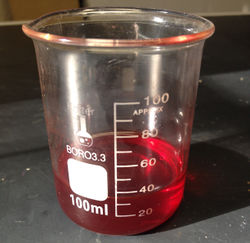Rosocyanine
 Solution of rosocyanine in concentrated hydrochloric acid. This sample required only 20mg of turmeric powder to produce.
| |
| Names | |
|---|---|
| IUPAC name
2-Methoxy-4-[(E)-2-[2,4,10-tris[(E)-2-(4-hydroxy-3-methoxyphenyl)ethenyl]-1,5,7,11-tetraoxa-6-boroniaspiro[5.5]undecan-8-yl]ethenyl]phenol chloride
| |
| Properties | |
| B(C21H19O6)2]Cl | |
| Molar mass | 781.013 g/mol |
| Appearance | Dark green (solid) Bright red (acidic sol.) |
| Almost insoluble | |
| Solubility | Sparingly soluble in acetic acid, ethanol, pyridine, sulfuric acid Insoluble in halocarbons, hydrocarbons |
| Vapor pressure | ~ 0 mmHg |
| Hazards | |
| Safety data sheet | None |
| Related compounds | |
| Related compounds
|
Curcumin |
| Except where otherwise noted, data are given for materials in their standard state (at 25 °C [77 °F], 100 kPa). | |
| Infobox references | |
Rosocyanine is an ionic compound produced by the reaction between curcumin, a dye found in the spice, turmeric, and boric acid or borates.
Contents
Properties
Chemical
Rosocyanine is a somewhat unstable compound that is prone to decomposition in strongly alkaline conditions or when heated in air, and can be difficult to isolate due to these factors. It briefly produces a deep blue or violet coloration upon addition to strong bases such as ammonia.
Physical
Rosocyanine in pure form is a glassy dark green crystalline substance, but forms deeply red solutions at even very low concentrations. It is only very slightly soluble in lower alcohols and other organic solvents, but solubility increases slightly with the addition of acids.
Availability
As of yet, rosocyanine is not thought to be available to home chemists, most likely stemming from its lack of significant uses for any purpose.
Preparation
Rosocyanine can be produced from a mixed alcoholic solution of boric acid and curcumin via the addition of a strong acid, such as concentrated hydrochloric or sulfuric acids. A brief period of heating may be required, but overheating or boiling can decompose the rosocyanine to pseudo-curcumin. If an orange or weak red coloration is obtained this way, the addition of more acid is necessary.
Projects
- Determine boron content in food and substances
Handling
Safety
Little is known about rosocyanine's effects on organisms. Therefore, one should not let this compound enter your body.
Storage
Rosocyanine is unstable and cannot be stored for long periods of time.
Disposal
Rosocyanine is a sensible compound and can be safely disposed of.